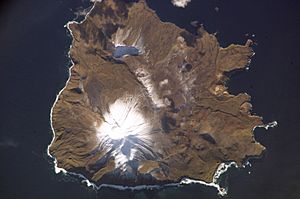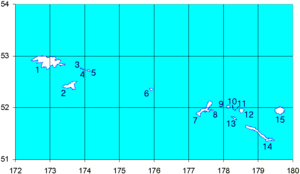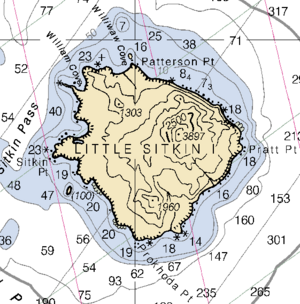Little Sitkin Island facts for kids

Little Sitkin Island (Aleut: Sitignax̂; Russian: Малый Ситкин) is a volcanic island. It is part of the Rat Islands chain in the Western Aleutian Islands, Alaska. The island is about 3 miles (4.8 km) east of Davidof Island. Another island, Great Sitkin Island, is 185 miles (298 km) further east.
Little Sitkin Island is mostly round, about 6 miles (9.7 km) wide. The inside of the island is very rough and mountainous. Only the lower parts are covered in grass. There are two main peaks. One is 3,898 feet (1,188 m) high in the northeast. The other is 1,960 feet (600 m) high in the south. Many streams flow on the island, but there are no lakes or ponds. The coast is generally steep and rocky. It has a band of kelp 200 to 400 yards (180 to 370 m) wide along the shore. Small steam vents and hot springs can be found in a valley on the northwest side of the island.
Contents
Little Sitkin Volcano: A Fiery History
Little Sitkin Island is home to a type of volcano called a stratovolcano. This means it's a tall, cone-shaped volcano built up by many layers of hardened lava and ash. This volcano has erupted several times in the past. Records show eruptions around 1776, 1828, and 1900. The 1776 eruption was likely very powerful and explosive.
How the Volcano Formed
The volcano on Little Sitkin Island has grown in stages. It has had three main periods of building up its cone shape. These building periods were separated by the creation of two calderas. A caldera is a large, bowl-shaped hollow that forms when the ground collapses after a volcanic eruption.
The oldest caldera, called Caldera One, is about 4.8 km (3.0 miles) wide. It formed where a very large stratovolcano once stood. The rocks from this old volcano are the oldest ones you can see on the island today.
Later, a second stratovolcano grew almost entirely inside Caldera One. This new volcano was made mostly of lava flows and reached a height of about 900 m (3,000 feet). A huge eruption, possibly after the last ice age, caused a second, smaller caldera to form. This new caldera, Caldera Two, partly destroyed the second cone. Caldera Two is oval-shaped, measuring 2.7 by 4 km (1.7 by 2.5 miles). The highest peak on the island today is part of what was left of this second cone after the caldera formed.
Recent Volcanic Activity
The most recent volcanic activity on Little Sitkin Island has mainly involved lava flows. There are two relatively new lava flows that have distinct edges, like walls. One of these flows came from the main crater of the volcano. The other came from a crack in the ground on the western side of the older Caldera One.
Earthquake Near the Island
On June 23, 2014, a very strong earthquake with a magnitude of 7.9 happened near Little Sitkin Island. People were told to leave the area for safety. Tsunami warnings were also issued shortly after the earthquake.
Plants and Animals of Little Sitkin
The island's plant life is mostly low-growing plants. These include leafy plants, moss, sedge, and grass. These plants grow widely at heights below 1,500 feet (460 m). There are very few woody plants like trees or shrubs.
Historically, there was a population of Arctic foxes on the island. In 1930, there were about 250 foxes. They survived by eating sea stars (echinoderms), snails, and insects. Small groups of sea birds and tiny sea creatures without backbones (marine invertebrates) have also been found on Little Sitkin Island.




